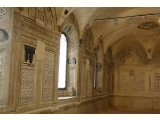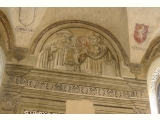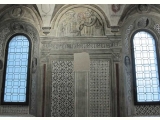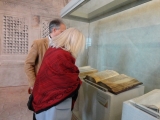Siete qui:
- Home
- The MODO Museum
- The Museums Venues
- Libreria Albèri
Libreria Albèri
The Albèri Library opened to the public in April 2012 after undergoing restoration for a few years. This suggestive ambience, strictly connected to the Cathedral, can be accessed from the Palazzi Papali Venue.
The marvellous hall was built in 1499 to host the Library of powerful Bishop Antonio Albèri (1423 - 1505 approximately) former archdeacon of the Duomo and preceptor of future Pope Pius III (born Piccolomini). Those were the years during which Luca Signorelli was in Orvieto to complete the Cappella Nova (or Chapel of San Brizio) with his marvellous frescoes, and the decorations on the walls can be most probably attributed to Signorelli and his assistants: profane subjects inspired by the artistic language of the Master from Cortona, conceived with that humanistic spirit that tried to join the Old Testament with the Classical culture at the time. And it seems that, according to the a recent hypothesis, the person appearing next to Signorelli at the beginning of the cycle of paintings inside San Brizio's Chapel was Antonio Albèri himself rather than Beato Angelico (an opinion that had lasted a long time).
Albèri commissioned this study room inspired by Siena's Piccolomini Library and in fact the two Libraries represent a unique and peculiar example of libraries adjacent to Cathedrals. He placed approximately 300 volumes of his impressive book collection, that unfortunately was lost over the centuries and decided to leave the Library and the books it contained by will to Orvieto's Opera del Duomo. Illuminated by four large windows opening to the south side of the Palazzi Apostolici, the Library is connected to the Cathedral by way of a door opening to the right side of the tribuna, which at the time was clear of the wooden chorus that was later installed around 1536. Only in 1890 was the beautiful painted decoration discovered below the white plaster.
The cycle of frescoes that decorated the walls of the hall, made between 1501 and 1503, is mainly dedicated to major authors in the disciplines included in the library sections: law, philosophy, medicine, history, astrology, rhetoric, grammar, poetry.
There is a peculiar and bizarre figure located in the wall frame near the last window in the south-western corner of the hall: A monkey wearing glasses and reading an open book on which the wording Legere et non intelligere est negligere.








